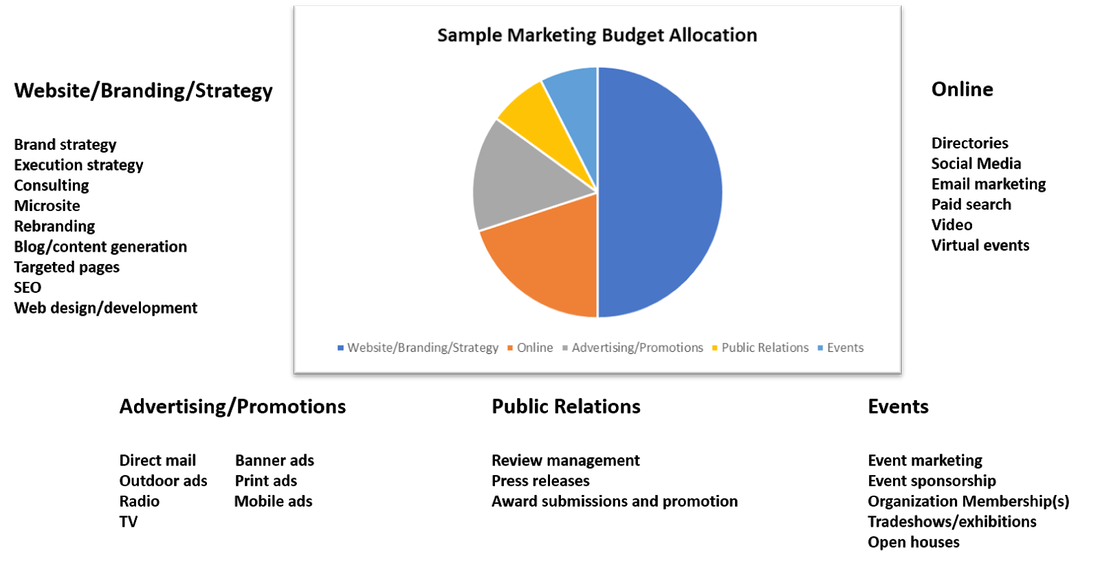|
Whether you’re starting a new business or running an established organization, one of the major dilemmas your team needs to answer is determining the appropriate budget for marketing. After all, you don’t want to invest heavily in developing a hip, niche product, only to end up with a fantastic product in your hands without the go-to market plan and promotional materials to drive awareness and sales.
In the mid-90s, Steve Jobs took Apple Inc. (which was on the brink of extinction) and turned it into one of the most valuable brands in the world. Jobs understood that a strong brand and marketing strategy is a powerful asset and a vital role in the success of any business, and Apple is one of many successful companies that spends more on marketing and sales than they do on research and development. However, unlike Apple and other global corporations, many small businesses struggle to balance between spending on marketing versus other operations because they have limited resources and capacity. This is why it is important to take time to evaluate your marketing objectives and prioritize specific marketing projects. Below, we will break down the marketing budget and discuss where to allocate your resources to optimize your marketing plan. Before You Start Refer to your marketing plan, if available. There are a few questions that you need to answer before you begin to set your marketing budget.
1. The random allocation approach—Possibly the most common method. Businesses that use this method follow no marketing strategy or plan. Budget is allocated based on impromptu efforts: “We need more sales; let’s have a campaign!”. 2. Keeping up with the Jones approach—Matching what the competitors are spending or reacting to a competitor’s increase in marketing efforts. Keep in mind that it is very difficult to establish what competitors are spending or how efficiently their budgets are being used. 3. The last year’s budget approach—Many organized businesses look at previous budgets and make upward or downward adjustments based on their evaluations. 4. The percentage of turnover approach—Organizations that use this method strive to establish an accepted marketing spend based on percentage of turnover (sum of money that the organization has collected from its normal business practices such as sale of goods and services). The generally accepted spend for a business in a steady state is 5%-8% of turnover, higher for new businesses or if there is a need to open a new market. Note: If there are major changes in strategy, do not base your budget on previous budgets as those are likely to be irrelevant. 5. The task orientated approach—This method involves looking at the strategy and tallying up the costs of all planned marketing activities to arrive at the marketing budget. This may create a figure that you are not comfortable with, but it is the most strategic method. 6. The hybrid approach—Many businesses will incorporate several of these methods to come up with a realistic and flexible marketing budget that matches strategy with affordability. Other Considerations… Aside from selecting the appropriate budgeting approach, you also need to think about what you’re really investing in. Remember that advertising, trade shows, social media, mobile apps, etc. are only tools to help you gain and retain customers. Thus, your first consideration should be “how much is a customer worth?” The most straightforward way to calculate customer lifetime value (CLV) is to subtract the revenue you earn from a customer by the money spent on acquiring and serving that customer, where the total revenue you can expect to get from each customer is your average order value divided by one minus the repeat purchase rate. An example: Let's say that the value of an average order at your restaurant is $35. Also, anytime someone makes an order there is a 15% chance of the customer m coming back and making a repeat purchase. Finally, let's assume that it costs you $10 to acquire each new customer. (Figures are purely assumptions for demonstration purposes.) CLV = [$35 / (1 - 0.15)] - $10 = $31.17 Your second consideration should be “what is the average conversion rate from inquiry to customer?” Conversion rates (CR) are calculated by dividing the number of conversions by the number of total impressions, multiply by 100. An example: your site had 2,000 visitors last month and produced 125 sales. (Figures are purely assumptions for demonstration purposes.) CR = 15/2,000 x 100 = 6.25% The point is that a marketing budget should not be perceived as an expense towards a single, immediate sale; rather, it is an investment in making and keeping a customer for the long-term. Industry Standards By this point, you’re probably still wondering what other organizations are spending on marketing, just to gain a point of reference. The answer is: It varies by industry. Below are some figures gathered in a 2017 CMO survey published by the American Marketing Association. Percent of revenue by industry:
Where to Spend Using the SBA recommendation as a reference point, you may want to consider setting a 5% of revenue marketing budget for your regular marketing activities, with added spending on periods that require extra marketing efforts to meet changes in strategy or to upgrade/enhance your marketing foundation. In general, your marketing foundation should include:
Essentially, your marketing foundations consist of establishing your brand, defining your missions and values, and building your basic communication platforms. Efforts toward building and maintaining your marketing foundations fall under brand development. You may also use budgeting approaches 3, 4, or 5 to determine the appropriate amount for your marketing foundations. Depending on your industry, you may need to invest more in promotional campaigns during certain seasons or years to capitalized on additional traffic. Or, you may simply want to run a couple spontaneous campaigns to temporarily boost your sales. This is where you can tap into the remain 2-3 percent of your marketing budget, or implement budgeting approach 1 or 2 to meet your marketing needs. Separating your marketing budget into brand development and promotional campaigns helps you maintain a degree of flexibility and bridge strategy with affordability.
0 Comments
Leave a Reply. |
© COPYRIGHT 2019. ALL RIGHTS RESERVED.



 RSS Feed
RSS Feed